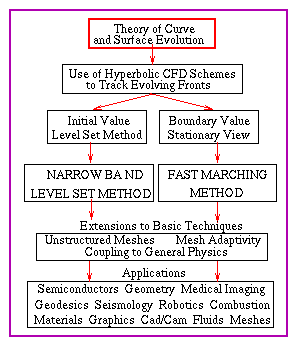OVERVIEW
APPLICATIONS
INTERACTIVE APPLETS
HISTORY OF THE METHODS/FLOW CHART
PUBLICATIONS
EDUCATIONAL MATERIAL
ACKNOWLEDGEMENTS
ABOUT THE AUTHOR/CV
Copyright:
1996, 1999, 2006
J.A. Sethian
Starting Point: Theory of Curve and Surface Evolution
Central Idea:
One starting point for both Fast Marching Methods and Level Set Methods, which
are numerical techniques for tracking propagating interfaces, comes
from the analysis of curve and surface evolution
presented in Refs. #1 and #2. This analysis introduced the
ideas that
- Corners and expansions in propagating interfaces
are equivalent to shocks and rarefactions fans in shocks.
- An entropy condition is required to correctly continue solutions
past the occurrence of singularities.
- Curvature in propagating fronts plays the same role
as viscosity in hyperbolic conservation laws, in that it smooths
out these singularities and ensures a smooth solution for all time.
- Consequently, interface motion can be cast in the language of
hyperbolic conservation laws.
- Marker particle schemes are unstable, and pick out a
non-entropy solution.
- Corners and expansions in propagating interfaces are equivalent to shocks and rarefactions fans in shocks.
- An entropy condition is required to correctly continue solutions past the occurrence of singularities.
- Curvature in propagating fronts plays the same role as viscosity in hyperbolic conservation laws, in that it smooths out these singularities and ensures a smooth solution for all time.
- Consequently, interface motion can be cast in the language of hyperbolic conservation laws.
- Marker particle schemes are unstable, and pick out a non-entropy solution.
|
You are currently in the topic outlined in red. |

Click on navigable flow chart to go to new topic |
Click on any text to go to a new topic. |
Annotated References:
-
Ref #1 links hyperbolic conservation laws to
evolving fronts.
It starts with
a propagating curve, and analyzes its motion.
If the motion contains a curvature term of a certain form,
then the curve removes smooth for all time as it moves.
If the curve moves at constant
speed, it develops corners, where the solution is no longer
differentiable. After such a slope discontinuity
develops, an entropy condition is required to continue the solution
as an appropriate "weak" solution. Reference #1 gives an
entropy condition, shows that the limit as the smoothing
term vanishes is in fact the entropy-satisfying weak solution.
-
Ref. #2 analyzes numerical schemes for fronts.
In particular,
it studies the stability as a function of the speed function,
studies the performance of various numerical schemes, shows
that marker particle techniques suffer from a particular form
of instability that is difficult to rectify, and studies
the performance of a volume-of-fluid technique for propagating
interfaces.
Once this is done, the next step is to consider using numerical technology of shock schemes to directly move an interface.
Book and Resource on Level Set and Fast Marching Methods
References:
-
An Analysis of Flame Propagation
: Sethian, J.A., PhD. Dissertation, Dept. of Mathematics,
Univ. of California, Berkeley, 1982.Abstract
We develop a mathematical theory of flame propagation and analyze the stability of a flame front. We consider a premixed, combustible fluid and model the front between the burnt and unburnt regions as an infinitely thin curve propagating in a direction normal to itself at a constant speed. We assume that the specific volume of a fluid particle increases by a fixed amount when it burns.
Our results show a deep analogy between the equations of flame propagation and hyperbolic systems of conservation laws. We introduce the notion of ignition curves and an entropy condition which enable us to solve the equations of flame propagation in the absence of fluid motion. We prove that any initial front asymptotically approaches a circle as it burns, and that if two fronts start close to each other, they remain so. As the front moves, it may form cusps, which are the result of colliding ignition curves and form in the same way that shocks develop in the solution of hyperbolic systems. These cusps absorb sections of the flame front, destroying information about the initial shape of the front: once a cusp forms, it is impossible to retrieve the initial data by solving the equations of motion backwards in time. We use our theory to discuss the difficulties involved in a numerical approximation to the equations of flame propagation. Finally, we analyze a numerical technique, developed by Chorin, that does not rely on a discrete parameterization of the initial front, and use it to illustrate the results of our theorems.
Download publications
-
Curvature and the Evolution of Fronts
: Sethian, J.A., Communications of Mathematical Physics,
Vol. 101, No. 4, 1985Abstract
The evolution of a front propagating along its normal vector field with curvature dependent speed is considered. We define an "energy-like" quantity of the moving front, the total variation, and prove a general result relating the growth/decay of this energy to the speed. We then study a front moving with speed 1 - epsilon K, where epsilon is a constant and K is the curvature, and show that the curvature term plays a smoothing role in the solution similar to that of viscosity in Burgers equation. For epsilon =0, the solution is seen to blow up, differentiability is lost, and an entropy condition can be formulated to provide an explicit construction for a weak solution beyond blow up time. We numerically solve the equations of motion and show that the solution converges to the constructed weak solution as the curvature smoothing term vanishes. Corners that develop in the propagating front swallow variation in the solution, providing a discontinuous stabilizing mechanism. Finally, we discuss the difficulties involved in numerically solving such problems and a possible remedy is described.
Download publications